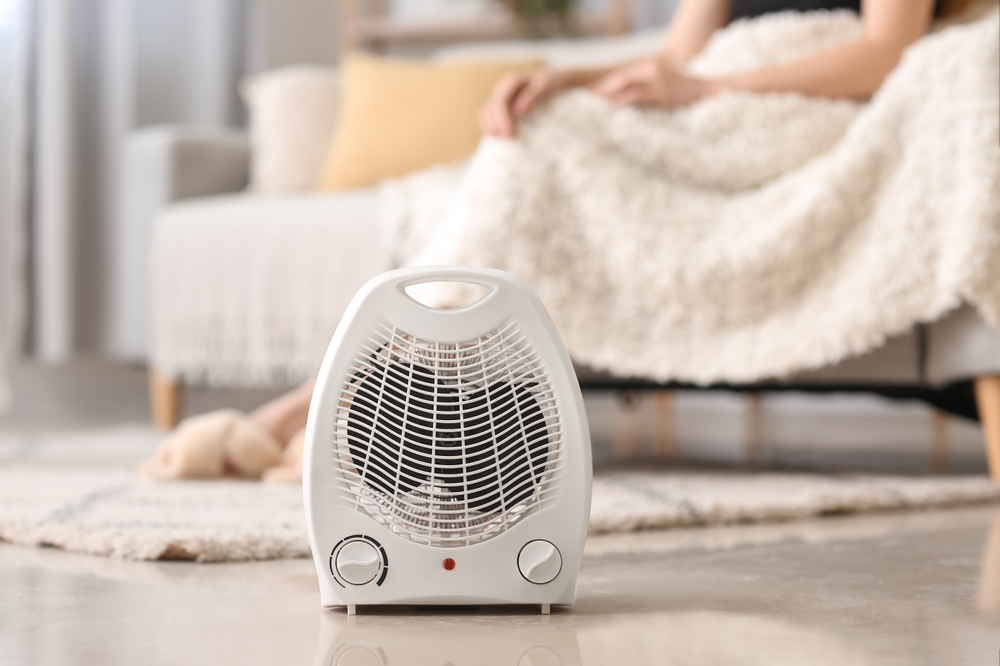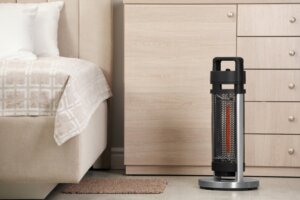Portable electric heaters are an inexpensive way to warm up cold areas that your home’s central heating system struggles to reach. However, they can be a fire hazard so it’s important to be safe when using one.
The most popular type of portable electric heaters are infrared space heaters, which have many benefits: they provide direct heat quickly, are very quiet, require very little maintenance, and the radiant heat they produce is focused, cost-effective and energy-efficient.
The problem is most portable electric heaters are high-wattage appliances that have a red-hot tungsten coil inside, with the potential to ignite nearby combustible materials like curtains, beds, sofas, paper, clothing, and flammable liquids. If ignition results from a heater left on and unattended, a major fire could result. In fact, more than 25,000 residential fires every year are associated with the use of electric space heaters, according to the U.S. Consumer Product Safety Commission (CPSC).
Tips for safe usage
Set-up
Avoid using an electrical heating device on the same circuit with another high wattage appliance, such as a microwave or toaster oven.
Never run the heater’s cord under rugs or carpeting. This can damage the cord, causing it and nearby objects to burn.
Make sure that all floors in your house are outfitted with a working smoke alarm before using a space heater.
Location is Key
Place your space heater in a safe position within the room, on a sturdy, flat surface where it will not be knocked over.
Position it at least one meter (three feet) away from anything flammable, such as upholstery, rugs, drapes, newspapers, bedding, clothing, or furniture.
Keep space heaters out of high-traffic areas such as doorways where they may be knocked over. Unplug the heater if using a robotic vacuum cleaner, which can knock it over.
Plug your space heater directly into a wall outlet, not an extension cord or power bar. These devices are more likely to overheat and cause a fire. Be sure the heater plug fits tightly into the wall outlet.
Keep electric space heaters away from areas with water. Check your manual to be sure the heater is intended to be used in wet areas like bathrooms or kitchens. To avoid a shock, never touch an electric heater if you are wet.
Before, During and After Each Use
Before each use, inspect your space heater for broken or cracked power cords and loose connections. Check electrical heating equipment regularly and replace loose, frayed or damaged cords. If you find any signs of disrepair, do not use it.
During use, check frequently to determine if the wall outlet is hot. If yes, stop using the heater, and have a qualified electrician check and/or replace the plug or faulty wall outlet. If the power cord is hot, disconnect the heater, and have it inspected by an authorized repair person.
Never leave a child or pet unsupervised around a space heater. Children may stick their fingers or other objects through the protective guards, causing burns or shock.
Do not leave a space heater “on” unattended or while you sleep – get extra blankets instead! (Surprisingly, according to a survey of homeowners by the Electrical Safety Foundation International [ESFI], 9% of those surveyed regularly left them unattended and a full 33% admitted to keeping their space heaters running overnight.)
After each use, unplug your space heater – do not simply switch it off.
Tips for buying a new space heater
Look on the carton for one of these safety certifications: Canadian Standards Association (CSA), Underwriters Laboratories (UL) or Intertek Group (ETL).
Choose one that automatically shuts off if it falls over or becomes overheated.
Get the right size. While smaller space heaters will provide a bit of extra warmth near a drafty window, others are large enough to heat entire rooms. If you’re looking for a small, personal heater to keep by your work space, you’ll only need a small unit that puts out about 250 watts or less. Larger space heaters can be 1500 watts or more.
Don’t buy electric space heaters to heat your entire house. One space heater is an efficient way to provide supplemental heat to a single room, but using multiple space heaters to heat your whole home is inefficient and ineffective.
Before setting up your new space heater, read the warning labels and manufacturer’s instructions for safe operation.
We hope you’ll use these tips to stay toasty warm this winter … and safe!

